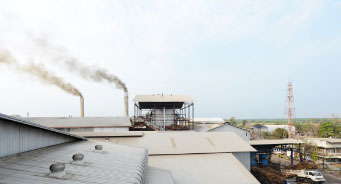Buriram Power Co., Ltd.
Buriram Power Company Limited "BPC" was registered on 2011 with currently paid-up registered in amount of 170 Million Baht in which BEC currently holds 99.99% of total shares. BPC was established to support the second biomass power plant of BSG with the capacity of 9.9 MW by using bagasse as a main fuel including other substitutable fuel materials such as woodchips, sugar leaves or chaff to generate electricity. BPC is located near BEC and BSF for convenience of bagasse logistics transportation. BPC sells the electricity to PEA under the power purchase agreement in FiT system by the maximum capacity of 8 MW at 22,000 volts electric potential system, and started the power purchase in April, 2015. Furthermore, BPC's electricity generation has been promoted on investment by Thailand Board of Investment on January 5, 2015.
General Information
The bagasse-based co-generation plant project is a small electricity plant with the capacity of 9.9 MW. The project is situated in Hin-lek-fai Sub–district, Koo-muang District, Buriram Province under the management of Buriram Power Co., Ltd. Electricity produced from this project is sold to the Provincial Electricity Authority (PEA) under Very Small Power Producer (VSPP) Program.
Location
The project is situated at No. 289, Moo 2, Sao-Eh Village, Hin-lek-fai Sub-district, Koo-muang District, Buriram Province with the adjacent areas, as follows:
adjacent to the area of biomass electricity generation plant
close to other persons land lots
adjacent to the plant of Buriram Sugar Factory Co., Ltd.
adjacent to a 2-lane public road and agricultural areas.
The project's land area is 46.96 rai, divisible into 5 main parts: electricity plant, water storage pond, green area, office, and fuel storage building.
Fuel
Source of fuel
The fuel used in the electricity production is bagasse that comes from Buriram Sugar Factory Co., Ltd.’s plant situated in the east of the electricity plant. The plant uses approximately 151,428 ton/year of bagasse in the production process (470.27 ton/day), while bagasse left over from sugar production process is approximately 280,000 ton/year.
Transportation of main fuel
Transportation of bio-fuel (bagasse) is done through conveyor belts which are connected with the 35-rai fuel storage field of Buriram Sugar Factory Co., Ltd. Fuel is conveyed on the belts and then kept in the fuel storage building situated in the project’s area.
Management- Preparation of fuel
When the fuel arrives at the storage building, it will be fed into the power generation process in a first-in-first-out fashion (FIFO). The storage building has a capacity to hold up to 5-day worth of fuel amount. Most fuel is directly conveyed to the project’s steam boilers.
Characteristics of Power Plant
-
Power generation
This project can generate up to 9.9 MW (Gross) of electricity. After discounting the1.5-MW generated power that is used in the plant, the remaining 8 MW of electricity (Net) will be sold to PEA under a Very Small Power Producer Program. The project has an objective to distribute the electricity of 71,280,000 kWh/year. It also has unused steam of 72,000 ton/year.
-
Fuel need
This project requires biofuel of around 470.27 ton/day. According to the analysis of components of the biofuel used, which is bagasse or rice husk, the amount of Sulfur generated in the power generation is quite low, only 0.05-0.07%. Therefore, the fume released from this plant as a product of its power generation contains a low level of SO2 contamination.
-
Power production process
The co-generation plant is a small power plant with the capacity of 9.9 MW. It generates electricity using steam from the boiler, which is heated by the burning of biomass. The steam generated has enough pressure and temperature to propel the steam turbine attached to the power generator. When the turbine is mobilized, it creates electricity currents at the power generator. The currents are then transformed from medium voltage (3,300 Volt) to high voltage (22,000 Volt) electricity by an electricity transformer. High voltage electricity current will then be transmitted through the PEA’s 22-Volt above-ground transmission lines which are 2 km. away from the plant site.

Pollution Control
Pollutants generated from this power plant are airborne. Air pollutant controlling systems are summarized as in the followings:

Sulfur Dioxide (SO2)
According to the analysis of bagasse fuel, it is found that bagasse contains 52% humidity and 0.05% wt of Sulfur. The project controls SO2 released from the project’s pipe to be not more than 60 ppm at 50% excess air or 7% excess O2 according to the determined standard.

Nitrogen Dioxide (NO2)
Contamination of NO2 can be restricted by controlling the rate at which the fan feeds the air into the burner. This will regulate the temperature in the burner and automatically control NO 2 contamination in the air to be not more than 200 ppm (50% Excess Air or 7% excess O 2).

Total suspended particulate (TSP)
Smoke from the combustion at a steam boiler will be led to a multi-cyclone dust collector system which can seize up to 60% of dust. Smaller particles will then be seized by the electrostatic precipitator, which has dust-control efficiency of 99.6%. The project will control the amount of TSP released to be not more than 120 mg/Nm3 of 50% excess air or 7% excess O2 according to the determined standard.